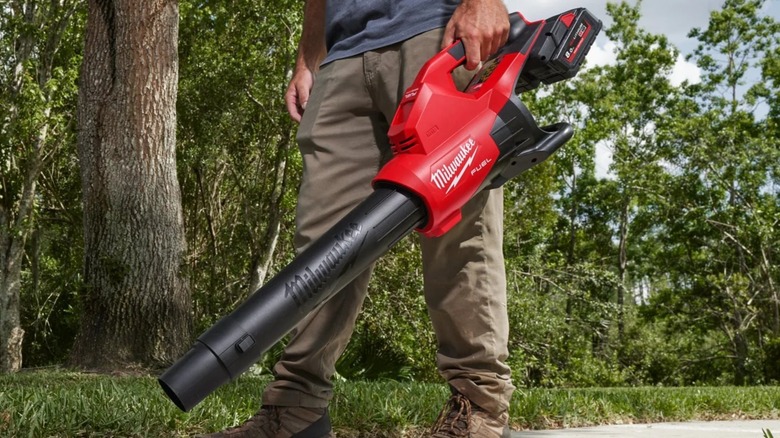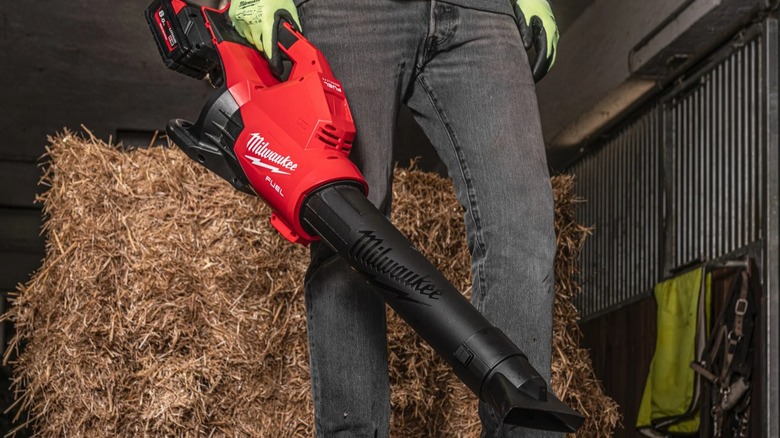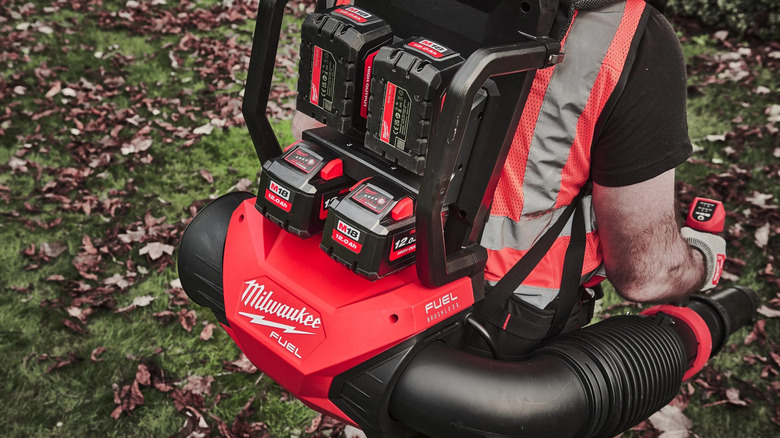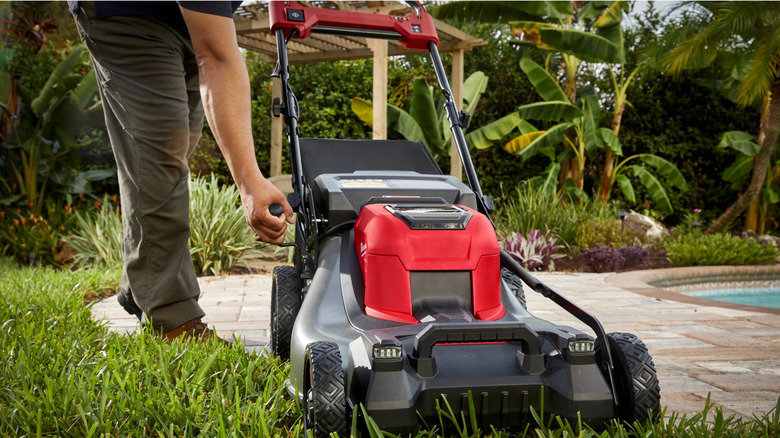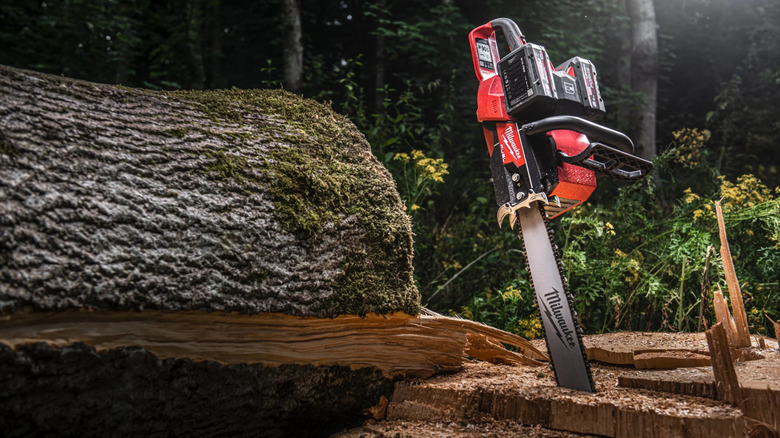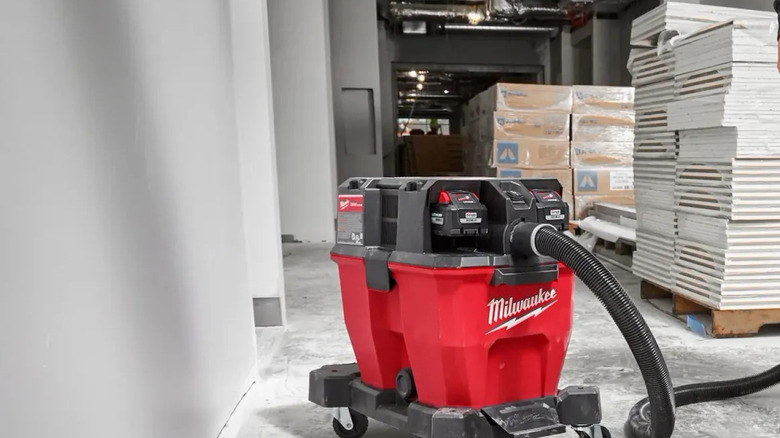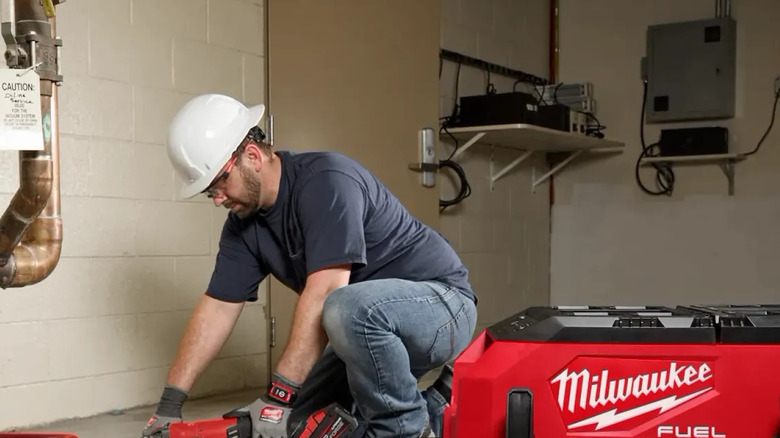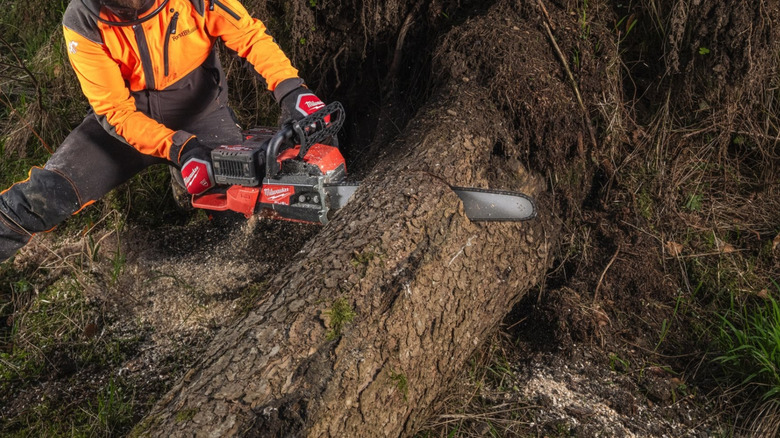Every Milwaukee Dual Battery Tool You Can Buy In The U.S.
We may receive a commission on purchases made from links.
Milwaukee makes a lot of power tools, from a humble line of USB-rechargeable gadgets to top-of-the-line brushless tools. But if you're looking for the brand's most powerful, longer-lasting, dangerously expensive tools, you want Milwaukee's dual-battery system. Unlike other brands, like Makita and its many battery types, Milwaukee doesn't have a line of tools with a battery voltage higher than the M18's 18 Volts. To circumvent this problem, the brand started equipping some of its best tools with two (and sometimes even four) 18V batteries, creating what is functionally a 36V tool line. But where other brands have categorized their dual battery line differently, like Makita's LXT 36V, Milwaukee seems content to let its most powerful tools live in the M18 line.
Since this is a list of dual-battery Milwaukee tools currently available in the USA, we had to exclude the recent M18 Fuel Dual Battery Brush Cutter, which appears to be available only in some stores and only in Europe and the U.K. Since it was only revealed in late February 2025, it's likely that this tool hasn't found its way to the U.S. yet, but it might do so eventually. Aside from this small exception, this article is a complete list of every Milwaukee M18 dual battery tool since all but one of them have been released in the U.S.
M18 Fuel Dual-Battery Blower
According to Milwaukee, the M18 Fuel Dual-Battery Blower has the highest constant power emission of any handheld blower, including "all handheld gas blowers." Has Milwaukee tested every gas blower on the market before making this claim? Probably not, but the 600 CFM and 145 mph of this tool are quite impressive. Comparing it to the single-battery variant from the same brand, the 120 mph and 450 CFM M18 Fuel Blower, we find that the increased energy stored allows it to move much, much more air at a slightly faster speed. It's hard to say if the dual-battery blower is just a more intense version of its predecessor or if it has a different motor, but it's clearly much more powerful than the first model. The Dual-Battery Blower has a long-lasting battery, too.
This tool might seem like a straightforward improvement over the single-battery version with no major drawbacks, but there's one area where the dual-battery can't hope to compete, and it's in affordability. Milwaukee's power tools are expensive even on the best of days, so of course, a new and improved, more powerful variant of an existing tool will end up being even more luxurious. The single-battery blower is already $178.99, making the $287.00 for the dual-battery seem almost quaint; after all, it's just $100 more for a significantly more powerful tool. However, that perception is skewed by the original's high price when compared to other brands. Ryobi, for one, will sell you a similar blower for $129.00, batteries included. We're also excluding batteries from the price. Batteries are expensive, and the dual-battery model uses two of them, which can cost well over $200.
M18 Fuel Dual-Battery Backpack Blower
If the price of the dual-battery blower is too much for you, then you won't even consider the M18 Fuel Dual-Battery Backpack Blower. Coming in at $499 (sometimes discounted to $449), the Backpack Blower is definitely not handheld, resting on a backpack with its two, and up to four, heavy batteries. And while this tool is more powerful than Milwaukee's other dual-battery blower, with 650 CFM and 155 mph, it's hard to say if the difference is really worth the extra money and hassle. They're both overpowered, and they're bound to feel like it, regardless of which one you go with. That said, the backpack is definitely going to make it easier to carry those heavy batteries.
You'd expect a tool that can be powered by twice as many batteries to last twice as long as the others, and according to Milwaukee, four HD 18V/12Ah batteries buy you between 30 minutes and an hour of work. Meanwhile, users claim they can get about 20 minutes with two 18V/8Ah batteries on the dual-battery blower. Two XC 18V/8Ah batteries come in at $449.00, charger included, or $736 when added to the price of the smaller blower. Meanwhile, two 18V/12Ah with a fancy 6-port rapid charger plus two standalone batteries of the same kind come in at a whopping $1,200, meaning a full package including the backpack blower, all the batteries, and a charger costs about $1,700, or $1,499.00 in a pre-made kit. Is a slight improvement worth the price hike? You'll have to decide for yourself.
M18 Fuel 17-Inch Dual-Battery String Trimmer
The M18 Fuel 17-Inch Dual-Battery String Trimmer is one of the most powerful electric weed eaters available from Milwaukee, and it's one of the best on the market overall. Compared to the smaller 16-inch Single-Battery String Trimmer variant, it has a slightly larger cutting swath that tops at 17 inches and a more powerful engine (3.8 HP against 1.76 of the single-battery model), but exactly the same top speed. It's fair to say, then, that the price difference between the $399 of the 17-inch and the $299 of the 16-inch (to say nothing of the cost of buying two batteries instead of one) is only worth it if you really need a more powerful motor in your weed wacker.
What's the point of a high HP string trimmer that doesn't rotate any faster than the technically less powerful version? According to ProToolReviews, who tested and reviewed both products, the dual-battery tool might be best if you plan on using thick 0.105-inch line. According to the reviewer, this line can be used on the smaller model, but "it's outside the scope of what Milwaukee designed for daily use." Otherwise, the two tools seem to be quite similar. The 16-inch model has two speed settings, while the 17-inch model has three, but they cover the same total range of RPMs. The dual-battery string trimmer can last longer than the other when equipped with large 12Ah batteries, but the two 8Ah ones that the all-in-one bundle comes with seem to equal the battery life of one 12Ah battery on the 16-inch one, at least according to ProToolReviews's test.
M18 Fuel 21-Inch Self-Propelled Dual-Battery Mower
The M18 Fuel 21-Inch Self-Propelled Dual-Battery Mower is almost certainly the most powerful Milwaukee lawnmower, but is it strong enough to do a job that is often reserved for larger batteries and gas-powered engines? According to Milwaukee, when equipped with two Redlithium High Output HD 12Ah batteries, this tool can rival the torque of a 200cc gas mower engine and still run for up to 60 minutes when removing "medium grass" one inch tall. Of course, you don't need 60 minutes of autonomy for routine cleanups of a small private garden, let alone 90 minutes (roughly equivalent to 3/4 of an acre) when removing light grass.
Most users will be fine with a cheaper, smaller mower that doesn't need two of the most expensive 18V batteries on the market to function properly (though you can power the Dual-Battery mower with 8Ah batteries instead). If you already have those batteries, or if you have other Milwaukee products to use them with, then this might be the best choice for a mower, even if you won't use it to its full potential. If you don't, then you might have to switch brands entirely. As far as alternatives go, DeWalt's 28-Inch 3-In-1 Lawn Mower is worth considering. Failing that, most reliable push lawn mowers from other good brands will usually be cheaper than the Milwaukee while being capable of taking care of a mid-sized lawn.
M18 Fuel 20-Inch Dual-Battery Chainsaw
The M18 Fuel 20-Inch Dual-Battery Chainsaw is quite powerful, with 4.4 HP in Standard Power mode, but capable of reaching a maximum of 5.8 HP in Peak Power mode. According to Milwaukee, that's enough to rival a 70cc gas engine. That said, even when using two bulky and expensive Redlithium XC 8 Ah batteries, this dual-battery chainsaw only lasts about 60 cuts of 10-inch hardwood. While that's going to be enough for every DIYer and even many professionals, it doesn't seem like the most powerful battery-powered chainsaw from one of the best and most popular power tool brands. There's also the issue of price and audience. If you're a homeowner, this is probably overkill, and you could get away with a tool far cheaper than $869.99.
However, if you're a professional, you might not want to use this as your daily driver anyway. The 20 inches of the chainsaw bar are not all that much, all things considered, and carrying more batteries with you for a long day of work isn't really comparable to bringing more gas, first of all in terms of price. Still, there are some benefits to battery-powered chainsaws: they are easier to use and maintain (you don't have to mix gas, for one), have immediate throttle response, and, according to Milwaukee, can have a higher peak torque for faster cutting times. However, you don't need the most powerful electric chainsaws available to benefit from those advantages. Milwaukee sells a number of smaller chainsaws like the 14-Inch Single-Battery Top Handle Chainsaw, which, while not exactly cheap, is still a bit cheaper.
M18 Fuel 9 Gallon Dual-Battery Wet/Dry Vacuum
The main difference between the M18 Fuel 9 Gallon Dual-Battery Wet/Dry Vacuum and the 12-gallon variant seems to be the size of the tank since both models recommend using two Redlithium High Output HD 12Ah batteries, and both can run for 34 minutes in standard mode or 49 in Max Runtime mode. Still, the two clearly have different case uses, or there wouldn't be two of them. The 9-gallon variant is seemingly less efficient than the alternative, at least when it comes to surface covered per charge. While this tool covers at most 1,600 feet squared when dealing with light debris, the bigger shop vac goes up to 1,800 feet squared. This difference is unlikely to have anything to do with the battery and more with how much debris the two tanks can take.
As for what the 9-gallon vacuum can do, Milwaukee claims this cordless tool can deliver more power than a corded equivalent, thanks to its 4.25 HP motor. Is that true? It's hard to say since Milwaukee does not provide figures for air volume or water lift, which is how vacuums are usually measured. The kit it's sold with includes the standard accessories you'd expect from any vacuum cleaner, like a flexible hose, crevice and large floor nozzle, and a "high-efficiency filter." A compatible HEPA filter is available separately, as are Milwaukee's fleece fust bags, which are not essential but are supposed to increase the duration of the filter.
M18 Fuel 12 Gallon Dual-Battery Wet/Dry Vacuum
The M18 Fuel 12 Gallon Dual-Battery Wet/Dry Vacuum is a powerful vacuum with a big tank, but it seems to be available exclusively in a kit with a lot of accessories, a charger, and two 12Ah batteries. Those last two are the most important part of the kit since they're likely responsible for over half of the total price of the whole thing. Either way, the reason this tool and the 9-gallons vacuum are so similar is that both use the same Milwaukee Dual-Battery Wet/Dry Vacuum motor head, the model 0921-20, which by itself costs just $199.00.
Of course, this similarity means that this tool, too, is hard to compare to the best shop vacuums from other major brands since Milwaukee didn't publish any measurements of its suction strength. Still, this big wet/dry vacuum has a lot of reviews, and the vast majority of them are very positive, so it's safe to say it's a solid product. It's also easy to adapt to your needs, equipped as it is with the multi-fit connector Air-Tip, which, as Milwaukee puts it, can fit other brands in three common sizes of hoses and nozzles: 1 and 1/4-inch, 1 and 7/8-inch, and 2 and 1/2-inch.
M18 Fuel 9 Gallon Dual-Battery Dust Extractor
The last of the M18 Dual-Battery tools is another strong vacuum-powered tool, but the M18 Fuel 9 Gallon Dual-Battery Dust Extractor is not your average wet/dry shop vac, though it is capable of water absorption. As the name says, this is a dust extractor that connects to sanders, drills, saws, and more, removing dust at the source. Not only is this more efficient, but it's also safer, especially in places where a lot of woodworking takes place. That might include your garage or home lab, but it's likely to be a bigger issue in professional environments like factories. This makes dust extractors, and especially big, dual-battery models like this one, best suited for professionals and serious hobbyists.
If you don't have $799.99 to spare (batteries not included), you might want to take a look at Milwaukee's other dust management solutions. You might also want to take a look at some dust collector systems that are perfect for a small shop. What the Milwaukee Dual-Battery Dust Extractor has that puts it above some of the competition is the high autonomy and power (for a cordless solution, at least) and the compatibility with many useful Milwaukee Packout storage options. This dust extractor is also part of Vaclink, a "wireless dust control technology" that allows the machine to be activated remotely or using the tools it's attached to. While this quality-of-life improvement might be worth it for a professional, it's unlikely to be a deciding factor for an occasional user.
Methodology
For this article, we selected every dual-battery tool made by Milwaukee currently released in the USA. We chose to exclude announced but unreleased tools as well as the gear that was not available for purchase in the United States at the time of writing. We found the items on this list by searching Milwaukee's website and various American hardware stores. Please note this is not a ranked list, and the items aren't arranged in order of quality as well as by any other relevant metric, but also according to what we believed would make for a pleasant reading experience.
